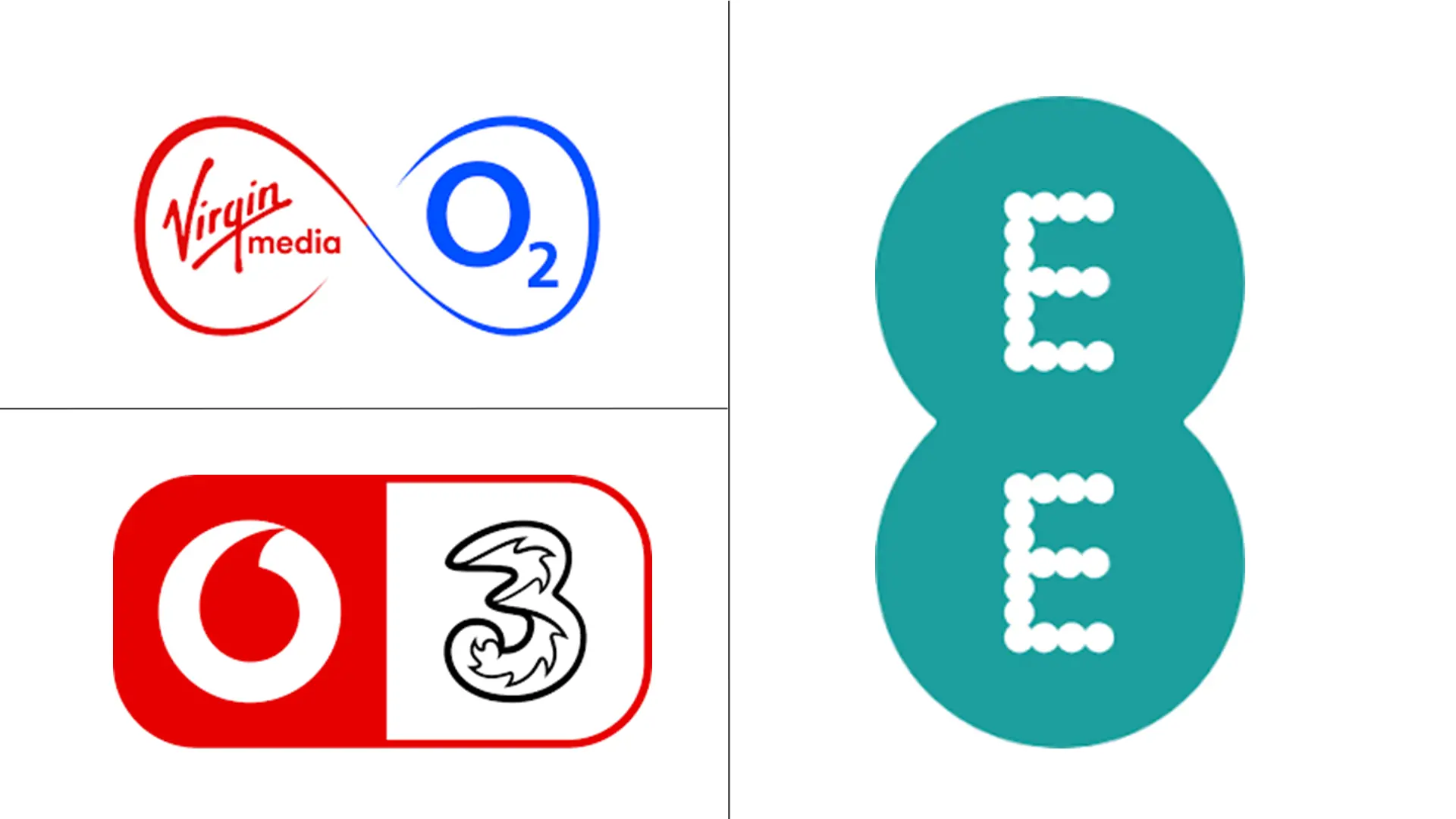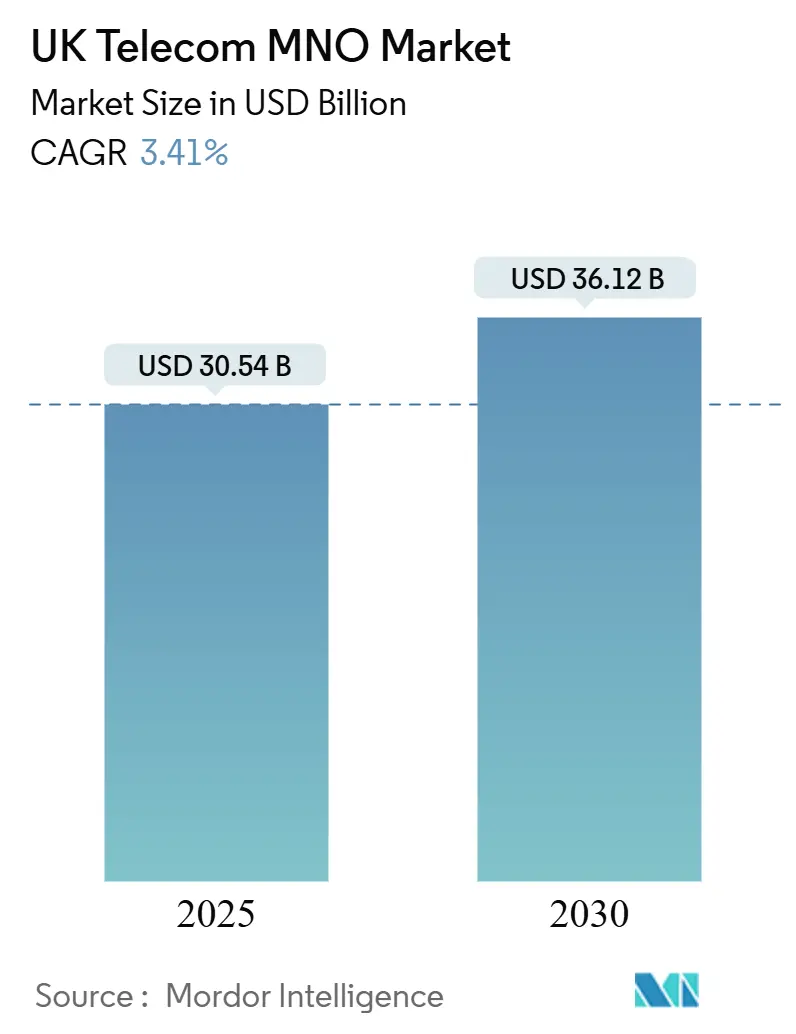
UK Telecom MNO Market Analysis by Mordor Intelligence
The UK Telecom MNO Market size is estimated at USD 30.54 billion in 2025, and is expected to reach USD 36.12 billion by 2030, at a CAGR of 3.41% during the forecast period (2025-2030). In terms of subscriber volume, the market is expected to grow from 101.70 million subscribers in 2025 to 113.37 million subscribers by 2030, at a CAGR of 2.20% during the forecast period (2025-2030).
Rising data consumption, accelerating 5G standalone roll-outs, and a decisive shift toward enterprise-grade connectivity underpin steady revenue expansion despite regulatory pressure on consumer tariffs. The completion of the Vodafone–Three merger in May 2025 has reshaped the competitive landscape, creating a three-player oligopoly that places renewed emphasis on network quality and bundled propositions. Enterprise digitization, especially across post-Brexit logistics corridors, is expanding demand for private networks, while the Shared Rural Network (SRN) initiative unlocks latent rural demand without compromising operator capital discipline. Intensifying energy costs and spectrum fees, however, continue to weigh on EBITDA margins and drive collaborative infrastructure strategies such as RAN sharing and green-site retrofits.
Key Report Takeaways
- By service type, data and internet services led with a 40.01% share of the UK Telecom MNO market size in 2024. IoT and M2M services are forecast to advance at a 3.47% CAGR through 2030.
- By end-user, consumer segments commanded 73.59% of the UK Telecom MNO market share in 2024, while enterprise segments are projected to post the highest CAGR of 3.79% to 2030.
UK Telecom MNO Market Trends and Insights
Drivers Impact Analysis
| Driver | (~) % Impact on CAGR Forecast | Geographic Relevance | Impact Timeline |
|---|---|---|---|
| 5G standalone roll-out accelerates premium ARPU uplift | +1.5% | London, Manchester, Birmingham and other metro areas | Medium term (2-4 years) |
| Fixed-mobile convergence bundles deepen churn reduction | +2.1% | National, strongest in suburban markets | Short term (≤ 2 years) |
| Shared Rural Network expands coverage into new demand pockets | +0.8% | Rural England, Scotland, Wales, Northern Ireland | Long term (≥ 4 years) |
| Enterprise IoT and private-network contracts scale post-Brexit logistics | +0.6% | Industrial corridors, ports, manufacturing hubs | Medium term (2-4 years) |
| Network-sharing and energy-efficient RAN cut OPEX 9-12% | +0.4% | National infrastructure deployments | Short term (≤ 2 years) |
| CPI+3.9% annual tariff indexing protects top-line growth | +0.3% | National consumer and enterprise segments | Short term (≤ 2 years) |
| Source: Mordor Intelligence | |||
5G Standalone roll-out accelerates premium ARPU uplift
EE’s launch of 5G standalone (SA) across 18 million people by February 2025 validated the commercial upside of a full 5G core, unlocking low-latency applications and differentiated service tiers that command higher monthly fees [1]Iain Morris, “BT aims to resuscitate 5G with major ‘standalone’ rollout,” Light Reading, lightreading.com. Network slicing trials at Glastonbury cut payment-terminal failures by 40%, illustrating immediate enterprise benefits [2]Mark Jackson, “Vodafone UK demo tested 5G SA network slicing at Glastonbury,” ispreview.co.uk. BT’s Adastral Park demonstrations showed 4K video and cloud gaming potential, reinforcing the monetization thesis for premium connectivity [3]Dan Robinson, “5G network slicing finally shown to be more than pipe dream,” The Register, theregister.com. Early ARPU uplift is therefore linked less to subscriber additions and more to tiered performance guarantees. As VodafoneThree extends “5G Ultra” to 23 cities, competitive dynamics hinge on SA coverage parity, suggesting a virtuous circle where service differentiation funds further rollout.
Fixed-mobile convergence bundles deepen churn reduction
Virgin Media O2 integrated the top five video-streaming services into its Flex bundle, capturing 90% of the content market and pushing monthly churn below sector averages. EE’s unlimited-data household bundles boost customer lifetime value by 25-30% through cross-selling. VodafoneThree plans to follow with unified TV and broadband offers aimed at Sky’s base, leveraging the merged spectrum to lower acquisition costs. These convergence plays resonate most in suburban households that value single-provider convenience, directly supporting price stability in an environment now restricted by Ofcom’s inflation-linked price-rise ban. The bundling trend, therefore, acts as a frontline defense against MVNO defection.
Shared Rural Network expands coverage into new demand pockets
The SRN targets 95% 4G geographic coverage by end-2025, with Scotland at 74% land-mass coverage and Wales at 80%, up sharply from 2023 baselines. Collaborative build reduces capex by 60% in sparsely populated zones, enabling operators to monetize previously uneconomic territories. Northern Ireland’s 85% coverage success demonstrates how cross-border spectrum coordination accelerates rural reach. While rural 5G remains in the teens for coverage percent, the incremental uplift in 4G creates a launch pad for future SA deployments as device ecosystems mature. New revenue opportunities span agricultural IoT, telemedicine, and remote working, each predicated on reliable primary coverage.
Enterprise IoT and private-network contracts scale post-Brexit logistics
Vodafone Business expects private 5G deployments to double or triple in 2026 as manufacturers and logistics operators demand deterministic connectivity for automation and real-time tracking. Harwell Science Campus and the Port of Blyth highlight early adoption. The UK’s local-access licensing model lowers spectrum barriers, while the disruption of EU supply chains forces domestic warehouses to digitize rapidly. Resulting bandwidth, latency, and security requirements make private LTE/5G an appealing alternative to Wi-Fi. The segment’s compound growth adds 0.6 percentage points to overall market CAGR, reinforcing the strategic pivot toward B2B revenue diversification.
Restraints Impact Analysis
| Restraint | (~) % Impact on CAGR Forecast | Geographic Relevance | Impact Timeline |
|---|---|---|---|
| Spectrum and energy costs squeeze EBITDA margins | -0.7% | National infrastructure operations | Short term (≤ 2 years) |
| CMA scrutiny of Vodafone–Three merger delays capex plans | -0.5% | National network deployment schedules | Medium term (2-4 years) |
| MVNO migration dilutes headline ARPU in cost-of-living crisis | -0.4% | Urban and suburban consumer segments | Short term (≤ 2 years) |
| Net-zero targets front-load capex for greener networks | -0.3% | National infrastructure modernization | Long term (≥ 4 years) |
| Source: Mordor Intelligence | |||
Spectrum and energy costs squeeze EBITDA margins
Annual spectrum fees nearing USD 400 million and a 23% uptick in energy prices have pushed the cost share of spectrum and power to 15-20% of network OPEX, up from 8-12% in prior cycles [4]GSMA, “Spectrum pricing and impact on 5G investment,” gsma.com . Operators now weigh rural expansion against margin preservation, sparking a surge in network-sharing agreements that deliver 9-12% OPEX savings yet only partially offset structural inflation. Energy-efficient RAN hardware and AI-driven power-management software are rolling out, but payback periods lengthen as wholesale electricity prices remain elevated. Unless spectrum fee policy softens, investment velocity could slow, particularly in lower-return rural zones.
CMA scrutiny of Vodafone–Three merger delays capex plans
The Competition and Markets Authority’s prolonged review deferred USD 13.8 billion in pledged investment by 18 months, permitting EE to widen its 5G lead during the waiting period. The merged entity must now accelerate spend to hit 99% 5G SA coverage by 2034, compressing cash-flow buffers in the early integration phase. Regulatory caution toward consolidation could also chill future M&A, preserving a policy environment that prioritizes consumer pricing over infrastructure scale.
Segment Analysis
By Service Type: Data Dominance Drives IoT Innovation
Data and Internet services retained 40.01% of the UK Telecom MNO market size in 2024, anchoring revenue even as IoT and M2M services race ahead at a 3.47% CAGR through 2030. Cellular IoT connections rose to 3.8 billion in 2024, supporting operators’ pivot to managed IoT platforms that offset declining voice and messaging revenues. OTT and PayTV integration through bundles such as Virgin Media O2’s streaming-heavy Flex package expands average household spend, showcasing new upsell paths that complement pure connectivity. Despite ARPU pressure, the segment’s rising volume and value-added analytics preserve overall profitability.
Vodafone’s move into end-to-end IoT solutions illustrates a broader industry shift toward platform and analytics revenues rather than SIM sales alone. Network slicing under 5G SA enables operators to guarantee low-latency lanes for industrial IoT, positioning them to capture enterprise budgets previously allocated to proprietary wireless systems. While other services like roaming and wholesale remain steady contributors, their growth trails IoT’s momentum. Sustained investment in SA coverage will therefore determine how fully operators can capitalize on next-generation machine connectivity.
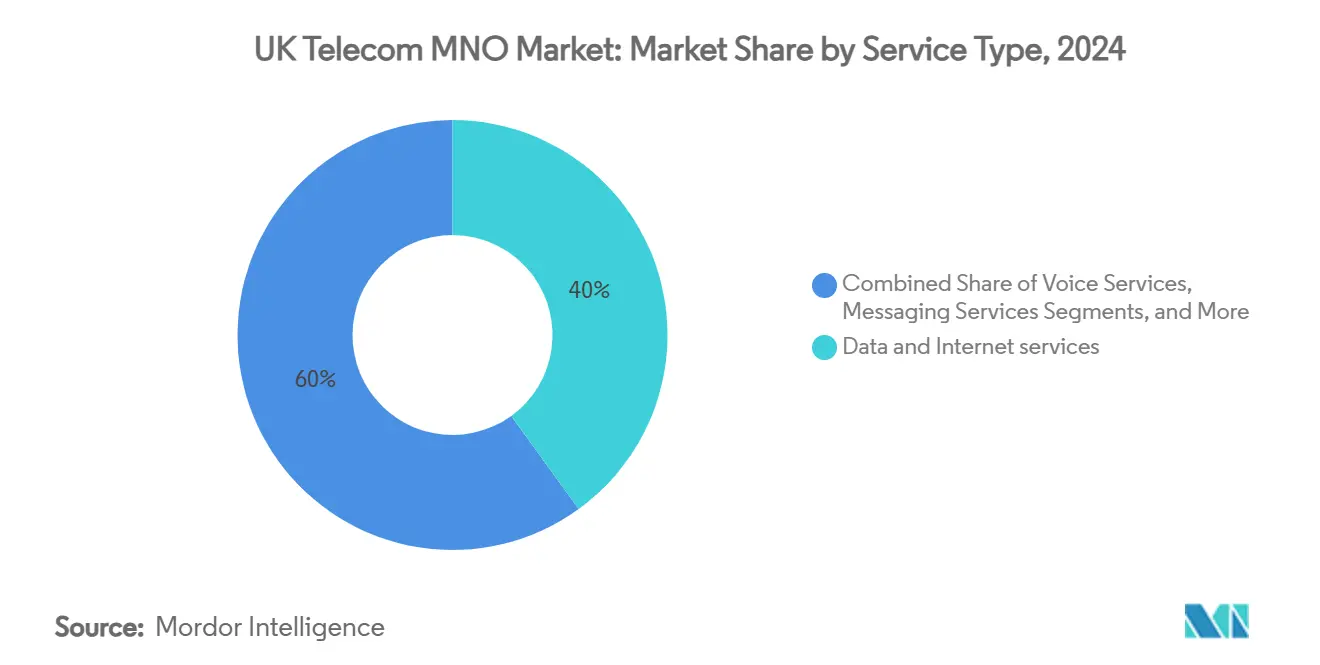
Note: Segment shares of all individual segments available upon report purchase
By End User: Enterprise Acceleration Outpaces Consumer Growth
Consumer accounts held 73.59% of the UK Telecom MNO market share in 2024, yet enterprise revenue is set to grow faster at a 3.79% CAGR, shifting the strategic center of gravity toward B2B offerings. Inflation-driven belt-tightening and MVNO competition limit consumer ARPU uplift, whereas enterprises are willing to pay premiums for guaranteed service levels. Post-Brexit supply-chain realignments have triggered a wave of connectivity overhauls in ports and factories, accelerating adoption of private networks and managed services.
Operators increasingly craft outcome-based contracts that embed connectivity inside broader solutions, driving stickier multi-year revenue streams. Vodafone Business forecasts a doubling or tripling of private-network sites by 2026, a signal that enterprise demand may outpace deployed capacity. Consumer growth, while still material, now hinges on convergence bundles and differentiated content rather than pure mobile access. As a result, the enterprise slice of the UK Telecom MNO market size could meaningfully erode the consumer dominance over the forecast horizon.
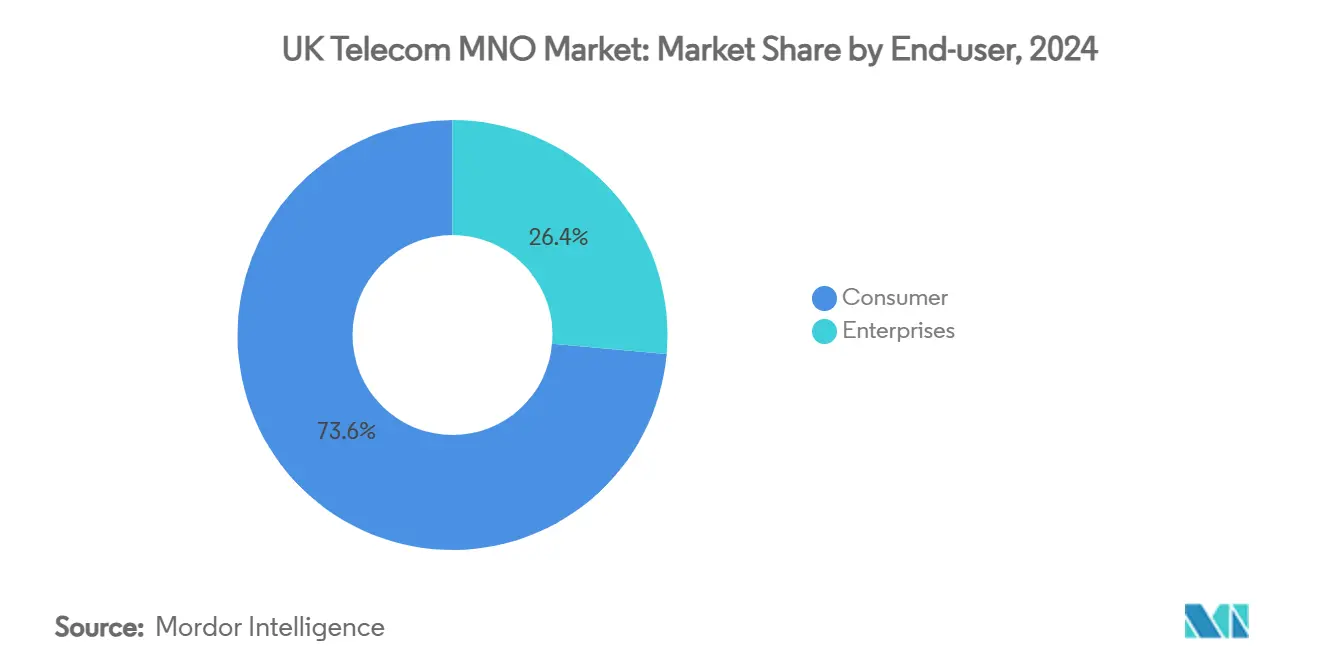
Geography Analysis
England’s densely populated economic hubs generate an outsized 35-40% of national revenue, despite housing only one-quarter of the population, underscoring higher ARPU and rapid uptake of premium services in business districts. Scotland’s 74% land-mass 4G coverage reflects robust SRN progress, yet rural 5G availability still lags urban centers by over 40 percentage points, a gap that offers growth headroom as SA deployments widen. Wales, at 80% coverage, leverages cost-sharing in mountainous zones to close long-standing digital divides, paving the way for smart-tourism initiatives and agricultural IoT.
Northern Ireland tops rural coverage at 85% after targeted SRN spending and cross-border collaboration with Irish carriers that optimize spectrum across shared geographies. This success positions the region for early adoption of farm automation and cross-port logistics solutions requiring reliable low-latency links. In England’s North East, 86% coverage supports manufacturing corridors, reinforcing the enterprise-IoT angle of regional economic development. National policy alignment between telecom targets and levelling-up agendas ensures that operators can secure co-funding for marginal coverage projects, enhancing capital efficiency.
Standalone 5G deployment remains concentrated in London, Manchester, Birmingham, and Edinburgh, giving early movers like EE a network-quality advantage that translates into lower churn and higher spend. Spectrum trades such as Virgin Media O2’s USD 430 million purchase from VodafoneThree unlock additional capacity in congested urban locales, preventing performance degradation as data usage accelerates. As SRN milestones are met, attention shifts toward rural 5G pilots, where network-slicing revenue could eventually rival that of urban markets once device ecosystems mature.
Competitive Landscape
The post-merger UK Telecom MNO market operates with three infrastructure players whose strategies diverge around network leadership, convergence, and enterprise focus. EE sustains technical dominance. VodafoneThree wields scale advantages by combining spectrum assets and subscriber bases, targeting 99% 5G SA coverage by 2034 and integrating mobile, fixed, and content to blunt churn. Virgin Media O2 differentiates through cable-backed broadband and aggressive spectrum infill, spending USD 430 million on new airwaves to bolster capacity in data-heavy urban cells.
MVNOs captured 1.7 million net adds in 2024, underscoring price sensitivity during the cost-of-living squeeze and forcing incumbents to defend share via loyalty-driven bundles rather than headline discounts. Energy inflation and spectrum fees press all operators toward shared infrastructures; joint ventures on passive towers and active RAN slices are expected to rise over 2025-2027, saving 9-12% in OPEX but risking homogenization of user experience. Competitive battlegrounds, therefore, shift to service innovation: network slicing, premium gaming tiers, fixed-wireless broadband, and enterprise SLAs.
Sustainability commitments add another competitive dimension, as operators vie to claim carbon-reduction milestones that increasingly influence enterprise procurement. EE’s AI-enabled power-management on SA sites, VodafoneThree’s pledge to 100% renewable energy by 2027, and Virgin Media O2’s circular-economy handset program illustrate differentiated ESG value propositions. Long-term success, however, will hinge on balancing green capex against the commercial imperative to out-deploy peers on 5G SA coverage.
UK Telecom MNO Industry Leaders
-
EE Limited (BT Group)
-
Virgin Media O2
-
VodafoneThree
- *Disclaimer: Major Players sorted in no particular order
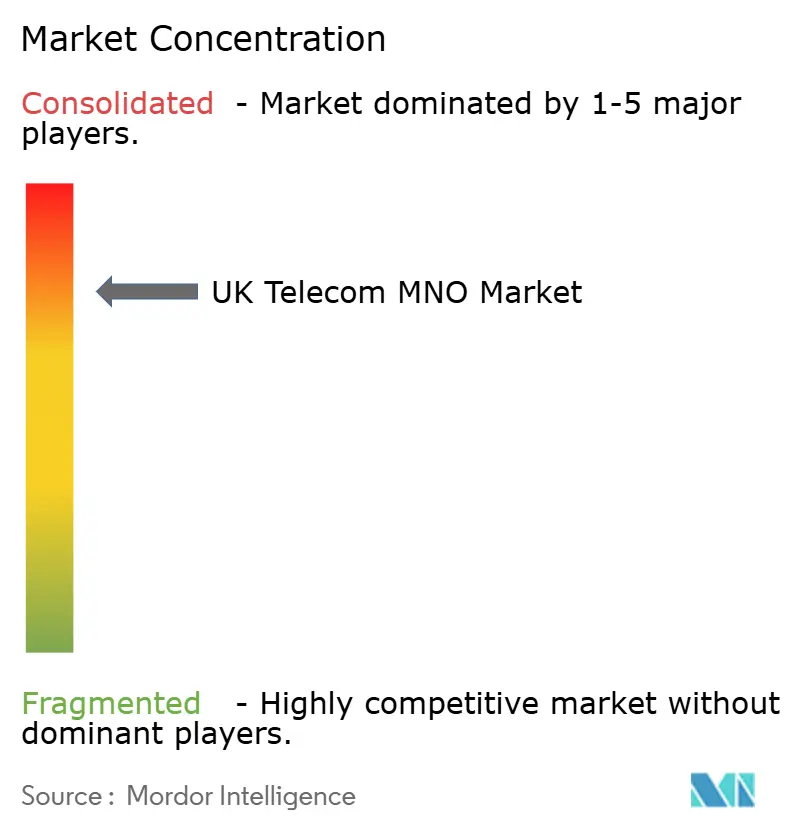
Recent Industry Developments
- June 2025: Virgin Media O2 completed a USD 430 million spectrum acquisition from Vodafone, boosting 5G capacity in dense urban markets.
- May 2025: Vodafone and Three UK closed their USD 19 billion merger, forming VodafoneThree with 27 million subscribers and a ten-year USD 13.8 billion network-investment plan.
- September 2024: EE activated its first nationwide 5G standalone clusters across 15 cities, combining AI-driven power management with fully independent 5G cores.
- August 2024: Bharti Global invested USD 3.2 billion for a 24.5% stake in BT Group, directing fresh capital into network modernization.
Research Methodology Framework and Report Scope
Market Definitions and Key Coverage
Our study defines the United Kingdom telecom market as all domestic revenue that licensed operators earn from mobile voice and data, fixed voice, fixed broadband, managed wholesale access, and Pay-TV/OTT add-ons sold within the UK territory. Revenue booked in sterling is converted to U.S. dollars using annual average exchange rates so global readers can compare figures easily.
Scope Exclusions: Network equipment sales, handset retailing, and any earnings that UK groups report from their non-UK subsidiaries remain outside this valuation.
Segmentation Overview
- Service Type
- Voice Services
- Data and Internet Services
- Messaging Services
- IoT and M2M Services
- OTT and PayTV Services
- Other Services (VAS, Roaming and International, Enterprise and Wholesale, etc.)
- End-user
- Enterprises
- Consumer
Detailed Research Methodology and Data Validation
Primary Research
To ground the desk findings, we interviewed network finance managers, wholesale product heads, rural fiber consortium leaders, and Ofcom policy advisers across England, Scotland, Wales, and Northern Ireland. Their insights on 5G uptake, fiber roll-out economics, and pricing outlook helped stress-test key elasticities and refine assumptions where published data were silent.
Desk Research
Mordor analysts began with authoritative, freely available datasets such as Ofcom's quarterly communications market reports, Office for National Statistics industry accounts, Department for Science, Innovation & Technology policy papers, and ITU and OECD telecom indicators. These establish subscriber counts, service mix, and historical spend patterns. Company filings housed on Companies House, investor presentations, and carefully screened press releases extend the financial picture, while policy consultation documents reveal regulatory cost drivers. Select paid resources, Dow Jones Factiva for deal flow and D&B Hoovers for operator segment splits, fill critical gaps. The sources cited above illustrate, not exhaust, the broad evidence base supporting our desk work; many additional materials inform validation and clarification.
Market-Sizing & Forecasting
A top-down construct starts with audited operator revenue, re-mapped to Mordor's service taxonomy and adjusted for currency, inter-operator eliminations, and VAT. These totals are then corroborated through selective bottom-up checks, sampled ARPU x active SIMs, fixed broadband ARPU x subscriber lines, and tower lease rates, to flag under- or over-statements. Variables that drive the model include household broadband penetration, 5G subscriber share, fiber-to-the-premises coverage, inflation-adjusted blended ARPU trends, spectrum fee trajectories, and enterprise ICT spending indices. Five-year outlooks employ a multivariate regression that links revenue to those indicators plus macro GDP, and scenario analysis captures policy or merger shocks. Where channel checks reveal volume gaps, interpolation guided by operator guidance bridges discontinuities before final triangulation.
Data Validation & Update Cycle
Model outputs move through anomaly filters, variance checks versus Ofcom and ONS benchmarks, and second-analyst review before sign-off. We refresh the dataset annually and trigger interim revisions when material events, tariff caps, major M&A, and spectrum auctions, shift the baseline. A final pre-publication sweep ensures clients receive the latest vetted view.
Why Mordor's UK Telecom Baseline Earns Investors' Trust
Published numbers rarely align because publishers differ on which services to count, how far forecasts stretch, and how often inputs refresh.
Key gap drivers include contrasting scope, some fold in device hardware or global subsidiaries, variation in currency translation points, treatment of wholesale transit fees, and refresh cadence that may ignore mid-year regulatory shifts. Mordor's disciplined, service-level mapping and annual operator filing reconciliation mitigate these skews, giving decision-makers a balanced anchor.
Benchmark comparison
| Market Size | Anonymized source | Primary gap driver |
|---|---|---|
| USD 35.90 B (2024) | Mordor Intelligence | - |
| USD 130.49 B (2025) | Global Consultancy A | Includes device sales and outbound roaming; currency blended across EMEA; no operator filing tie-back |
| USD 66.60 B (2024) | Industry Data Firm B | Uses regional ARPU extrapolation and overlooks UK wholesale offsets |
| USD 34.55 B (2024) | Regional Consultancy C | Reports retail streams only, omitting interconnect and leased-line revenues |
The comparison underscores that when scope discipline, data freshness, and dual-path validation align, as they do in Mordor's approach, the resulting baseline proves both transparent and repeatable, providing stakeholders with dependable guidance for strategic choices.
Key Questions Answered in the Report
What is the current value of the UK Telecom MNO market and its expected growth by 2030?
The market is valued at USD 30.54 billion in 2025 and is projected to reach USD 36.12 billion by 2030, reflecting a 3.41% CAGR.
How will the Vodafone–Three merger influence network investment plans?
The merged operator committed USD 13.8 billion over ten years, aiming for 99% 5G standalone coverage by 2034 after an 18-month regulatory delay.
Which service category is expanding the fastest in the UK mobile sector?
IoT and M2M services are forecast to grow at a 3.47% CAGR through 2030, outpacing traditional voice and messaging.
Why are enterprise customers becoming more important to UK mobile operators?
Enterprises seek private 5G networks for automation and logistics, offering higher-margin, solution-based revenue that grows at a 3.79% CAGR.
What role does the Shared Rural Network play in UK coverage targets?
The SRN aims to deliver 95% 4G geographic coverage by end-2025, cutting individual operator capex by about 60% in low-density areas while creating new rural demand pockets.
How are rising energy prices affecting network economics?
Energy inflation has lifted spectrum-plus-power costs to 15-20% of total OPEX, prompting operators to adopt energy-efficient RAN and share infrastructure to preserve margins.
Page last updated on:
